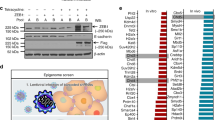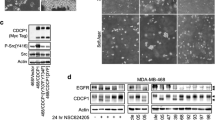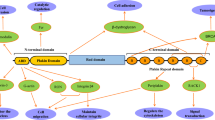Abstract
A class of adhesion protein that occurs in the membrane with both extracellular and intracellular domain and play vital role in maintaining multicellularity is TRASK, also called CUB-domain containing protein1, CD318 (CDCP1). Specifically, in the current study, documented aggressive grades of lung cancers and distant metastatic tissues were examined for protein interactions of Trask and compared with lung cancer variants in situ. The intracellular domain of Trask has the ability to undergo tyrosine phosphorylation and thereafter undergo increased genomic expression, as well as interact with cytoskeletal proteins in the cell periphery and other local signal transduction machinery to induce invadopodia formation and distant metastasis. We incorporated proximity ligation assay to examine protein interactions of Trask in metastatic lung cancer tissues and compare with advanced and low-grade lung cancers restricted to the primary site of origins. Here, we provide direct evidence that activated Trask, which is a phosphorylated form, binds with cytoskeletal proteins actin and spectrin. These interactions were not seen in locally growing lung cancer and cancer in situ. These interactions may be responsible for invadopodia formation and breaking free from a multicellular environment. Functional studies demonstrated interaction between Trask and the STOCs Orai1 and Stim1. Calcium release from internal stores was highest in metastatic lung cancers, suggesting this mechanism as an initial stimulus for the cells to respond chaotically to external growth factor stimulation, especially in aggressive metastatic variants of lung cancers. Recently, inhibitors of STOCs have been identified, and preclinical evidence may be obtained whether these drugs may be of benefit in preventing the deadly consequences of lung cancer.





Similar content being viewed by others
References
Chen VW, Ruiz BA, Hsieh MC, Wu XC, Ries LA, Lewis DR. Analysis of stage and clinical/prognostic factors for lung cancer from SEER registries: AJCC staging and collaborative stage data collection system. Cancer. 2014;120 Suppl 23:3781–92.
El-Sherief AH, Lau CT, Wu CC, Drake RL, Abbott GF, Rice TW. International association for the study of lung cancer (IASLC) lymph node map: radiologic review with CT illustration. Radiographics. 2014;34:1680–91.
Oyewumi MO, Alazizi A, Wehrung D, Manochakian R, Safadi FF. Emerging lung cancer therapeutic targets based on the pathogenesis of bone metastases. Int J Cell Biol. 2014;2014:236246.
Huang Q, Ouyang X. Predictive biochemical-markers for the development of brain metastases from lung cancer: clinical evidence and future directions. Cancer Epidemiol. 2013;37:703–7.
Eichler AF, Chung E, Kodack DP, Loeffler JS, Fukumura D, Jain RK. The biology of brain metastases-translation to new therapies. Nat Rev Clin Oncol. 2011;8:344–56.
Krishnan K, Khanna C, Helman LJ. The molecular biology of pulmonary metastasis. Thorac Surg Clin. 2006;16:115–24.
Schuette W. Treatment of brain metastases from lung cancer: chemotherapy. Lung Cancer. 2004;45 Suppl 2:S253–7.
Puduvalli VK. Brain metastases: biology and the role of the brain microenvironment. Curr Oncol Rep. 2001;3:467–75.
Nicolson GL. Paracrine and autocrine growth mechanisms in tumor metastasis to specific sites with particular emphasis on brain and lung metastasis. Cancer Metastasis Rev. 1993;12:325–43.
D'Antonio C, Passaro A, Gori B, Del Signore E, Migliorino MR, Ricciardi S, et al. Bone and brain metastasis in lung cancer: recent advances in therapeutic strategies. Ther Adv Med Oncol. 2014;6:101–14.
Wood SL, Pernemalm M, Crosbie PA, Whetton AD. The role of the tumor-microenvironment in lung cancer-metastasis and its relationship to potential therapeutic targets. Cancer Treat Rev. 2014;40:558–66.
Yamanaka R. Medical management of brain metastases from lung cancer (review). Oncol Rep. 2009;22:1269–76.
Chen G, Davies MA. Emerging insights into the molecular biology of brain metastases. Biochem Pharmacol. 2012;83:305–14.
Nathoo N, Chahlavi A, Barnett GH, Toms SA. Pathobiology of brain metastases. J Clin Pathol. 2005;58:237–42.
Hanibuchi M, Kim SJ, Fidler IJ, Nishioka Y. The molecular biology of lung cancer brain metastasis: an overview of current comprehensions and future perspectives. J Med Investig. 2014;61:241–53.
Spassov DS, Wong CH, Wong SY, Reiter JF, Moasser MM. Trask loss enhances tumorigenic growth by liberating integrin signaling and growth factor receptor cross-talk in unanchored cells. Cancer Res. 2013;73:1168–79.
Spassov DS, Ahuja D, Wong CH, Moasser MM. The structural features of Trask that mediate its anti-adhesive functions. PLoS One. 2011;6:e19154.
Spassov DS, Baehner FL, Wong CH, McDonough S, Moasser MM. The transmembrane src substrate Trask is an epithelial protein that signals during anchorage deprivation. Am J Pathol. 2009;174:1756–65.
Spassov DS, Wong CH, Sergina N, Ahuja D, Fried M, Sheppard D, et al. Phosphorylation of Trask by Src kinases inhibits integrin clustering and functions in exclusion with focal adhesion signaling. Mol Cell Biol. 2011;31:766–82.
Wong CH, Baehner FL, Spassov DS, Ahuja D, Wang D, Hann B, et al. Phosphorylation of the SRC epithelial substrate Trask is tightly regulated in normal epithelia but widespread in many human epithelial cancers. Clin Cancer Res. 2009;15:2311–22.
Lin CY, Chen HJ, Huang CC, Lai LC, Lu TP, Tseng GC, et al. ADAM9 promotes lung cancer metastases to brain by a plasminogen activator-based pathway. Cancer Res. 2014;74:5229–43.
Hansen MC, Nederby L, Henriksen MO, Hansen M, Nyvold CG. Sensitive ligand-based protein quantification using immuno-PCR: a critical review of single-probe and proximity ligation assays. Biotechniques. 2014;56:217–28.
Blokzijl A, Nong R, Darmanis S, Hertz E, Landegren U, et al. Protein biomarker validation via proximity ligation assays. Biochim Biophys Acta. 1844;2014:933–9.
Weibrecht I, Leuchowius KJ, Clausson CM, Conze T, Jarvius M, Howell WM, et al. Proximity ligation assays: a recent addition to the proteomics toolbox. Exp Rev Proteom. 2010;7:401–9.
Takkunen M, Hukkanen M, Liljeström M, Grenman R, Virtanen I. Podosome-like structures of non-invasive carcinoma cells are replaced in epithelial-mesenchymal transition by actin comet-embedded invadopodia. J Cell Mol Med. 2010;14:1569–93.
Sun J, Lu F, He H, Shen J, Messina J, Mathew R, et al. STIM1- and Orai1-mediated Ca2+ oscillation orchestrates invadopodium formation and melanoma invasion. J Cell Biol. 2014;207:535–48.
Guo A, Villén J, Kornhauser J, Lee KA, Stokes MP, Rikova K, et al. Signaling networks assembled by oncogenic EGFR and c-Met. Proc Natl Acad Sci U S A. 2008;105:692–7.
Murai R, Tanaka M, Takahashi Y, Kuribayashi K, Kobayashi D, Watanabe N. Stanniocalcin-1 promotes metastasis in a human breast cancer cell line through activation of PI3K. Clin Exp Metastasis. 2014;31:787–94.
Sheridan JT, Gilmore RC, Watson MJ, Archer CB, Tarran R. 17β-Estradiol inhibits phosphorylation of stromal interaction molecule 1 (STIM1) protein: implication for store-operated calcium entry and chronic lung diseases. J Biol Chem. 2013;288:33509–18.
Wang F, Liu DZ, Xu H, Li Y, Wang W, Liu BL, et al. Thapsigargin induces apoptosis by impairing cytoskeleton dynamics in human lung adenocarcinoma cells. Sci World J. 2014;2014:619050.
Hirooka S, Akashi T, Ando N, Suzuki Y, Ishida N, Kurata M, et al. Localization of the invadopodia-related proteins actinin-1 and cortactin to matrix-contact-side cytoplasm of cancer cells in surgically resected lung adenocarcinomas. Pathobiology. 2011;78:10–23.
Wang S, Li E, Gao Y, Wang Y, Guo Z, He J, et al. Study on invadopodia formation for lung carcinoma invasion with a microfluidic 3D culture device. PLoS One. 2013;8:e56448.
Conflicts of interest
None
Author information
Authors and Affiliations
Corresponding author
Rights and permissions
About this article
Cite this article
Wu, H., Shang, Lq., Chen, Rl. et al. Significance of Trask protein interactions in brain metastatic cohorts of lung cancers. Tumor Biol. 36, 4181–4187 (2015). https://doi.org/10.1007/s13277-015-3053-7
Received:
Accepted:
Published:
Issue Date:
DOI: https://doi.org/10.1007/s13277-015-3053-7




